Yekîneyên Parastina Gel T-55
The T-55 from Tamiya, out of the box. Much of this text is from my YPG T-72 article (q.v.), and I have taken a similar approach to weathering this kit.
In the ongoing Syrian civil war, the largely Kurdish west of the country is less of a conflict between the Free Syrian Army and Assad, and more of a conflict between the "Islamic State Of Iraq and the Levant" (ISIL / ISIS) and the "People's Protection Units" (Yekîneyên Parastina Gel / YPG) of the Kurdish Supreme Committee. With the fluid nature of war and the intricate, onion-like complexity of civil wars, it is difficult to accurately summarize the state of the conflict up to this point. However, the main position of the YPG is to prevent the greater Syrian conflict from spilling into Kurdish areas. The YPG is something of an anomaly in the Middle East, with a large number of women fighters and officers appointed by internal elections.
The YPG's armor force consists of vehicles captured from a variety of previous owners (ISIL, Assad loyalists, et cetera), and is a motley hodgepodge of whatever can be brought up to running order. The YPG has been recently crafting home-brewed armored vehicles by grafting armored shells on to civillian vehicles. Befitting vehicles that have had multiple owners, they're all looking a little worse for wear.
I had a T-55 and T-72 in the stash and decided to have some fun with them. Here is the T-55. I decided to use these kits as test mules for weathering techniques, so I didn't bother with any aftermarket. Here's what I did for the T-55. The hull and turret were assembled and given a full coat of Gunmetal Metalizer out of the rattle can. I prefer this for pre-shading over flat black because on styrene, it looks damned close to steel covered in mill scale. Since most images of YPG T-55s did not show them in severe states of disrepair, I did not go too crazy with "battle damage," but I did attack the turret with several grades of coarse sandpaper to give a rougher, cast-metal finish. I fitted the wheels on after giving them an appropriate amount of chipping, but I did not cement them in.
I sprayed the underside with Tamiya TS-2 Dark Green, then the sides with AS-6 Olive Drab, the topside of the hull with AS-14 Olive Green (USAF) and the turret AS-9 Dark Green. After this, I sprayed three rough lines of AS-11 Sea Grey over the whole topside of the tank, using a handheld piece of paper for an overspray guard. I then pulled the road wheels off their mounts and painted their tires black. They were then cemented in place. At this point, I started playing around with weathering techniques; some hairspray was applied to the gun barrel and turret, salt was applied to the hull. After everything was fully dried, I began misting TS-46 Light Sand and TS-3 Dark Yellow over the whole model, with an emphasis on the TS-3 to represent the ratty sand color most tanks in Syria seem to be sporting.
Once this coat was dry and the various media used as masks were removed, I started some touchup painting, like on the smoke grenade launcher caps, the rubber on the wheels that touches the treads and the searchlights. The tracks were sprayed with gunmetal and were slathered in a blend of various crushed and pulverized chalk pastels suspended in water. Once this was dry, I fitted the tracks to the model, and were secured to the tops of the road wheels with a drop of superglue. I know, everyone uses aftermarket tracks for their T-55 to achieve the proper sag, but for my purposes the rubber kit tracks work fine. Now the messy bit starts! To break up the uniformity of the sand and tan sprays, I took some very soft artist's pencils (6B) and began rubbing them on exposed metal edges. I then smeared this around the rest of the exposed edges with my fingertip. I worked the whole model from front to back, bottom to top until I was satisfied with the level of "scuffing" I had imparted. This is a good way to gently apply powdered graphite to large areas without using a brush or other tool, but if the graphite is soft enough your fingers will be BLACK before you are done-- put the model down and proceed directly to the sink and wash all that garbage off before you get the urge to touch ANYTHING, because it will get EVERYWHERE-- and skin is a lot easier to clean than a wall, or your pants or your pet. But I digress. The model then received some black watercolor washes on the engine deck and some highly thinned splashes of the aforementioned pastel slurry over the front. This was all sealed with a coat of testors dullcoat. I applied some burnt umber oil paint to places where I believe rust would have formed and then this too was sealed with another coat of dullcoat.
This particular model does not reflect any one specific YPG machine, but rather a conjectural model of a tank they may not have yet. Unfortunately, most of the photographs of YPG tanks are of the same group of four tanks-- two T-72s and two T-55s with varying field modifications. Other photographs of tanks in the possession of the YPG do not reveal much, if anything about the camouflage schemes worn by these machines, so some artistic license was taken. Photographs of YPG machines taken after this model was completed suggest that the YPG is adopting a quite bizzare camouflage consisting of colors that, to my mind, look a lot like pale RAF cockpit green, chocolate brown and pale desert pink (!) and I have included a photo of such a machine for further reference. Photographs of some YPG tanks have arabic numerals on the left side of the turret; the highest such number I've seen is 197568, so I numbered my tank 197570. The numbers were brush painted in white oil paint, while the YPG on the glacis was finely ground and moistened white chalk pastel.
The YPG flag was printed on plain printer paper and affixed to the aerial with white glue.
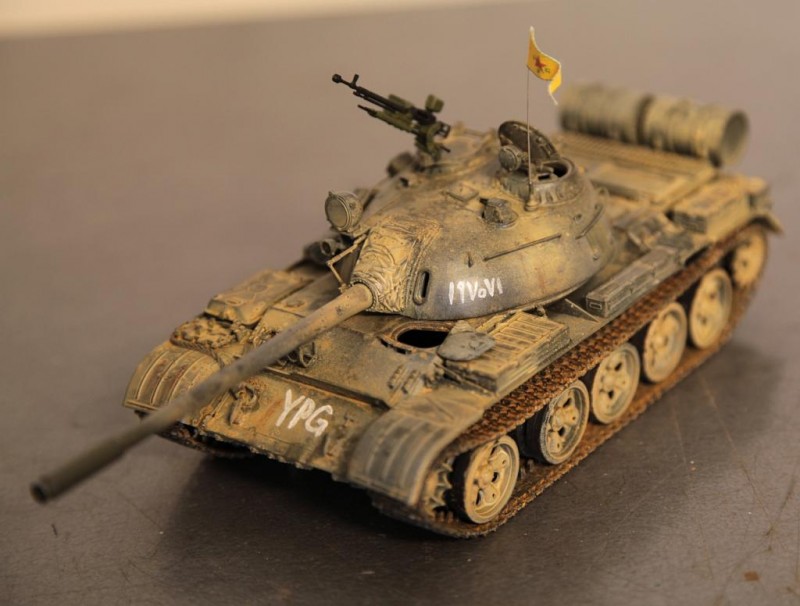
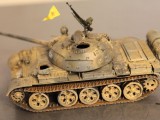
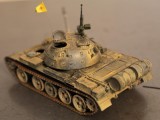
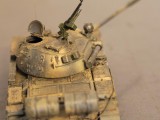
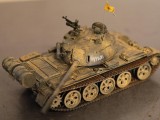
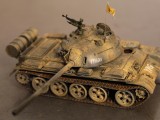

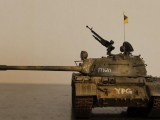
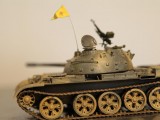
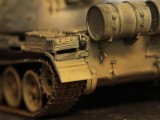
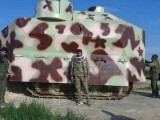
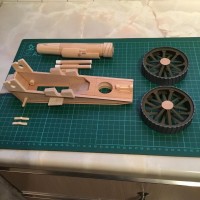
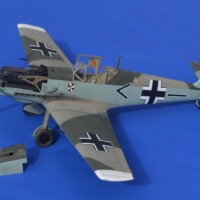
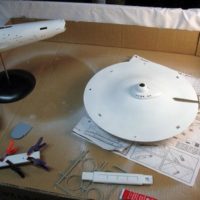
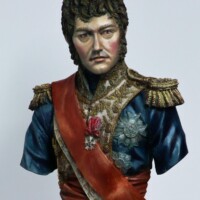
Artfully done, Wes...a very nice job indeed. And a very informative in-depth weathering tutorial as well...along with nice clear photos.
Another realistic looking piece of armor Wes.
GREAT T-55 !
Very convincing, just like your T72, Wes, great work. Thanks again for describing your weathering techniques so thoroughly. I'm tempted into having a go at some modern armour!
Beautiful work!
Great result Wes, and as others have said, thanks for your detailed description of the conflict and your weathering. Good research to build an unusual T-55.
This is amazing! Thanks for sharing your techniques also.
Thanks Wes, great build and very informative article
Well Done
Nice dirty build as it's appearence is very convincing.
Wes,
Gorgeous. Very well done.
Great build! My next project will be similar! Kudos!